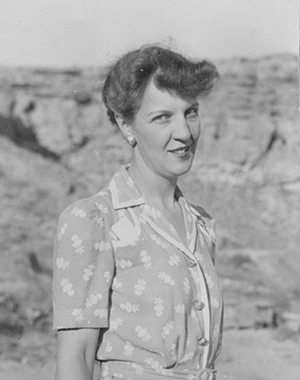

at Chaco Canyon, 1941. Photo courtesy of Armand Winfield.
This month we acknowledge Women’s History Month by celebrating some of the inspirational women who helped shape the Maxwell Museum.
Florence Hawley Ellis (1906-1991) never held a formal appointment in the UNM Museum of Anthropology (now the Maxwell Museum of Anthropology). From 1934 until her retirement from the University of New Mexico in 1971, she was a vital member of the UNM Department of Anthropology. A pioneer in dendrochronology, Dr. Ellis was a dedicated teacher and field researcher, who authored more than 300 publications. During her time at UNM, she directed numerous archaeological field projects, introducing countless students to New Mexico’s archaeological historical history. Ellis remained active in archaeology long after her retirement from UNM. The Florence Hawley Ellis Museum at Ghost Ranch, acknowledges the fieldwork she led on the ranch from 1971 until 1990. In addition to her archaeological fieldwork, Dr. Ellis worked with Zia, Santa Ana, Jemez, Nambe, Taos, Acoma, Laguna, Hopi and Santa Domingo on legal cases related to land and water rights. Many of the collections from her research, as well her field records and personal papers, are now curated in the Maxwell Museum and remain key resources for students, researchers, and descendent communities.
The Florence Hawley Ellis Papers (1859-2009; bulk 1950-1989) at the Maxwell Museum are extensive (see Online Finding Aid to her collection). Ellis' papers contain personal and professional records, such as correspondence, reports, drafts, notes, research materials and notes, conference papers, student work, colleague correspondence and articles, bibliographic note cards, and pottery classification cards. Also included is archaeological site documentation, (including field notes, maps and photographs) from the numerous UNM Archaeological Field Schools that Ellis directed. These include records from her fieldwork at Sapawe, San Gabriel del Yunque, Feather Cave, Tsama, Chaco Canyon, Gallina/Ghost Ranch, and more.
Materials from these sites, including ceramic vessels and sherds, flaked stone tools, animal bone, and yucca sandals, are curated in the Maxwell’s archaeological collections. They comprise hundreds of boxes available for research. Also in the archaeological collection are artifacts recovered during Ellis’ land claims work and 40-plus ceramic vessels from Ellis’ personal collection. In the Ethnology Division, collections from Florence Hawley Ellis include baskets, katsina dolls,, cradleboards, and more than 150 ceramic vessels, primarily from New Mexico pueblos, The Museum also holds a set of her personal field clothes, including her shoes, jeans, shirt, and bandana. These are on exhibit in a display dedicated to this distinguished UNM archaeologist in the Anthropology building.
To learn more about Florence Hawley Ellis, visit https://maxwellmuseum.unm.edu/news-events/blog/womeninculture-florence-hawley-ellis